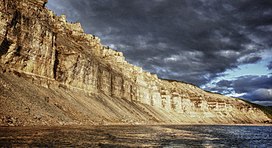오로라, 이사벨라
Aurora, Isabela오로라 | |
|---|---|
| 오로라 시 | |
 오로라 퍼블릭 마켓 | |
 오로라가 그려진 이사벨라 지도 | |
필리핀 내 위치 | |
| 좌표:16°59′31″N 121°38′08″E/16.991847°N 121.635689°E좌표: 16°59′31″N 121°38′08″E / 16.991847°N 121.635689°E | |
| 나라 | 필리핀 |
| 지역 | 카가얀 계곡 |
| 주 | 이자벨라 |
| 구 | 제5구 |
| 에 대해 명명됨 | 오로라 케존 |
| 바랑게이 | 33(바랑게이 참조) |
| 정부 | |
| • 유형 | 상무니앙바얀 |
| • 시장 | 조지프 크리스티안 G.유이 |
| • 부시장 | 멜빈 S. 마틴 |
| • 대표 | 파우스티노 마이클 카를로스 T.다이 3세 |
| • 유권자 | 유권자 2만3845명(2019년) |
| 면적 | |
| • 합계 | 115.56km2(44.62 sq mi) |
| 표고 | 62m(제곱 피트) |
| 최고 고도 | 90m(300ft) |
| 최저 고도 | 47m(제곱 피트) |
| 인구 (1998년 인구조사) | |
| • 합계 | 36,621 |
| • 밀도 | 320/km2(820/sq mi) |
| • 가구 | 8,434 |
| 이코노미 | |
| • 소득계층 | 제3기 시립 소득계층 |
| • 빈곤 발생 | 10.75% (2015)[4] |
| • 수익 | ₱150,597,297.10 (2020) |
| • 자산 | ₱711,562,140.43 (2020) |
| • 지출 | ₱201,196,142.71 (2020) |
| • 부채 | ₱139,860,274.96 (2020) |
| 서비스 제공업체 | |
| • 전기 | 이자벨라 2 전기 협동조합 (ISELCO 2) |
| 시간대 | UTC+8(PST) |
| 우편번호 | 3316 |
| PSGC | |
| IDD : 지역번호 | +63 (0)78 |
| 네이티브 언어 | 일로카노 타갈로그어 |
| 웹사이트 | www |
오로라, 공식적으로 오로라 자치구 (Ilocano:일리 ti 오로라, 타갈로그어:바얀 ng 오로라)는 필리핀 이사벨라 지방에 있는 3급 자치단체다.2020년 인구조사에 따르면 인구는 36,621명이다.[3]
바랑게이
오로라는 정치적으로 33개의 바랑게이로 세분된다. [5] 1927년 8월 27일 시군이 되었다.단지 하나의 바랑게이만이 도시적인 것으로 간주된다.[6]
기후
| 오로라, 이사벨라 기후 데이터 | |||||||||||||
|---|---|---|---|---|---|---|---|---|---|---|---|---|---|
| 월 | 얀 | 2월 | 3월 | 4월 | 5월 | 준 | 줄리 | 8월 | 9월 | 10월 | 11월 | 12월 | 연도 |
| 평균 높은 °C(°F) | 31 (88) | 31 (88) | 32 (90) | 34 (93) | 35 (95) | 34 (93) | 32 (90) | 32 (90) | 32 (90) | 32 (90) | 32 (90) | 31 (88) | 32 (90) |
| 평균 낮은 °C(°F) | 22 (72) | 22 (72) | 22 (72) | 24 (75) | 24 (75) | 24 (75) | 24 (75) | 24 (75) | 24 (75) | 23 (73) | 23 (73) | 22 (72) | 23 (74) |
| 평균 강수량 mm(인치) | 13.6 (0.54) | 10.4 (0.41) | 18.2 (0.72) | 15.7 (0.62) | 178.4 (7.02) | 227.9 (8.97) | 368 (14.5) | 306.6 (12.07) | 310.6 (12.23) | 215.7 (8.49) | 70.3 (2.77) | 31.1 (1.22) | 1,766.5 (69.56) |
| 평균 비 오는 날 | 3 | 2 | 2 | 4 | 14 | 16 | 23 | 21 | 24 | 15 | 10 | 6 | 140 |
| 출처: 월드 웨더 온라인[7] | |||||||||||||
인구통계학
| 연도 | Pop. | ±% p.a. |
|---|---|---|
| 1939 | 3,185 | — |
| 1948 | 7,797 | +10.46% |
| 1960 | 13,797 | +4.87% |
| 1970 | 16,035 | +1.51% |
| 1975 | 18,337 | +2.73% |
| 1980 | 20,322 | +2.08% |
| 1990 | 24,903 | +2.05% |
| 1995 | 26,385 | +1.09% |
| 2000 | 28,836 | +1.92% |
| 2007 | 31,547 | +1.25% |
| 2010 | 33,045 | +1.70% |
| 2015 | 35,017 | +1.11% |
| 2020 | 36,621 | +0.88% |
| 출처: 필리핀 통계청 | ||
2020년 인구조사에서 이사벨라 오로라의 인구는 36,621명으로, 밀도는 평방킬로미터당 320명 또는 평방마일당 830명이었다.
이코노미
| 오로라의 빈곤발생현황 | |
| 출처: 필리핀 통계청[12][13][14][15][16][17][18] | |
참조
- ^ 오로라 시 (DILG)
- ^ "2015 Census of Population, Report No. 3 – Population, Land Area, and Population Density" (PDF). Philippine Statistics Authority. Quezon City, Philippines. August 2016. ISSN 0117-1453. Archived (PDF) from the original on May 25, 2021. Retrieved July 16, 2021.
- ^ a b c Census of Population (2020). "Region II (Cagayan Valley)". Total Population by Province, City, Municipality and Barangay. PSA. Retrieved 8 July 2021.
- ^ https://psa.gov.ph/sites/default/files/City%20and%20Municipal-level%20Small%20Area%20Poverty%20Estimates_%202009%2C%202012%20and%202015_0.xlsx; 발행일: 2019년 7월 10일; 출판사: 필리핀 통계청.
- ^ "Province: Isabela". PSGC Interactive. Quezon City, Philippines: Philippine Statistics Authority. Retrieved 12 November 2016.
- ^ "Municipality of Aurora - Code:023103000". Philippine Standard Geographic Code (PSGC) Philippine Statistics Authority. June 30, 2021. Archived from the original on 2021-10-20. Retrieved October 20, 2021.
- ^ "Roxas, Isabela: Average Temperatures and Rainfall". World Weather Online. Retrieved 31 October 2015.
- ^ Census of Population (2015). "Region II (Cagayan Valley)". Total Population by Province, City, Municipality and Barangay. PSA. Retrieved 20 June 2016.
- ^ Census of Population and Housing (2010). "Region II (Cagayan Valley)". Total Population by Province, City, Municipality and Barangay. NSO. Retrieved 29 June 2016.
- ^ Censuses of Population (1903–2007). "Region II (Cagayan Valley)". Table 1. Population Enumerated in Various Censuses by Province/Highly Urbanized City: 1903 to 2007. NSO.
{{cite encyclopedia}}: CS1 maint : url-status (링크) - ^ "Province of Isabela". Municipality Population Data. Local Water Utilities Administration Research Division. Retrieved 17 December 2016.
- ^ "Poverty incidence (PI):". Philippine Statistics Authority. Retrieved 28 December 2020.
- ^ https://psa.gov.ph/sites/default/files/NSCB_LocalPovertyPhilippines_0.pdf; 발행일: 2005년 11월 29일; 출판사: 필리핀 통계청.
- ^ https://psa.gov.ph/sites/default/files/2003%20SAE%20of%20poverty%20%28Full%20Report%29_1.pdf; 발행일: 2009년 3월 23일; 출판사: 필리핀 통계청.
- ^ https://psa.gov.ph/sites/default/files/2006%20and%202009%20City%20and%20Municipal%20Level%20Poverty%20Estimates_0_1.pdf; 발행일: 2012년 8월 3일; 출판사: 필리핀 통계청.
- ^ https://psa.gov.ph/sites/default/files/2012%20Municipal%20and%20City%20Level%20Poverty%20Estima7tes%20Publication%20%281%29.pdf; 발행일: 2016년 5월 31일; 출판사: 필리핀 통계청.
- ^ https://psa.gov.ph/sites/default/files/City%20and%20Municipal-level%20Small%20Area%20Poverty%20Estimates_%202009%2C%202012%20and%202015_0.xlsx; 발행일: 2019년 7월 10일; 출판사: 필리핀 통계청.
- ^ "PSA Releases the 2018 Municipal and City Level Poverty Estimates". Philippine Statistics Authority. 15 December 2021. Retrieved 22 January 2022.
외부 링크




